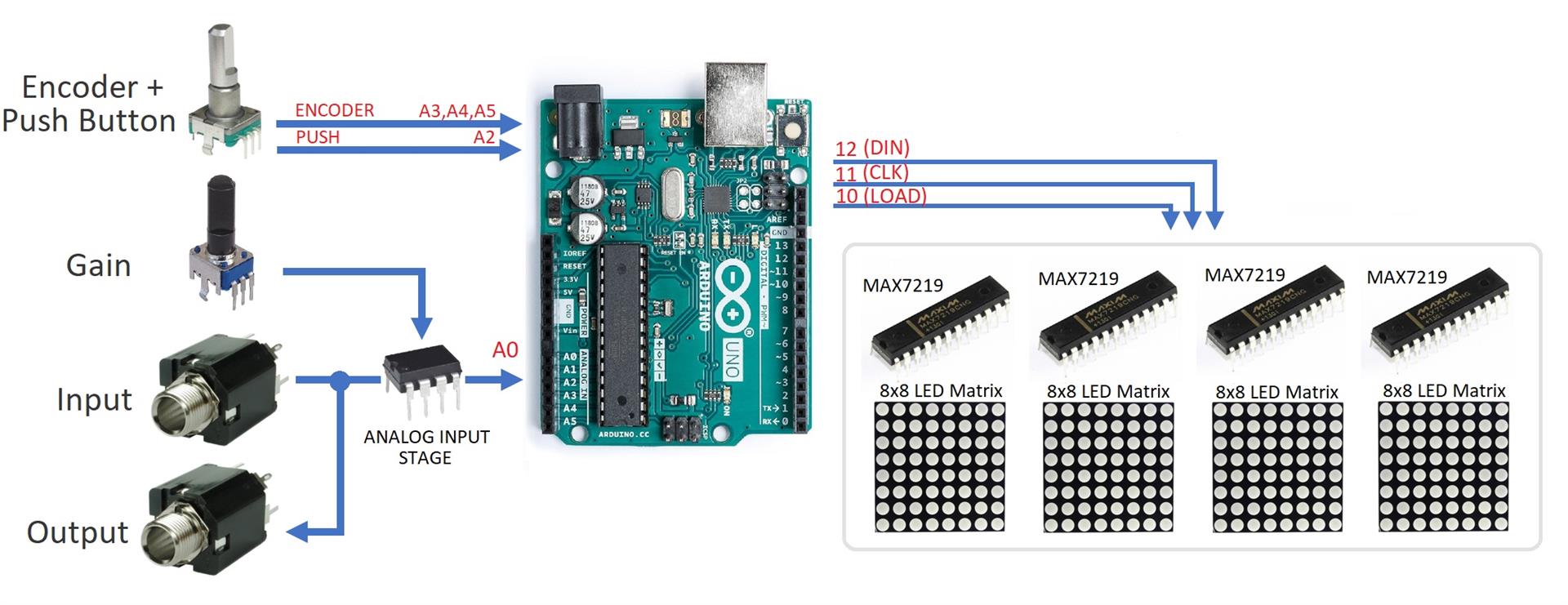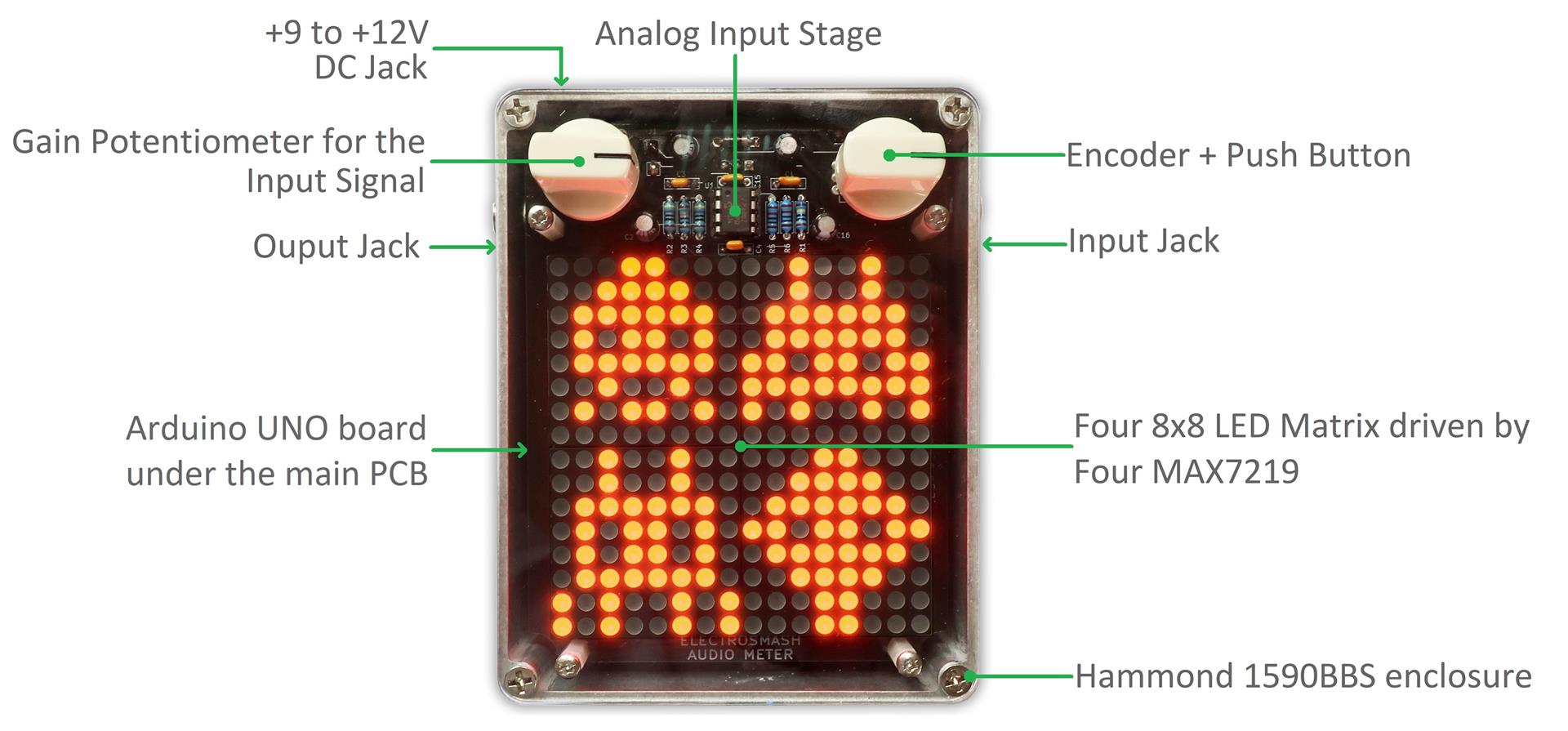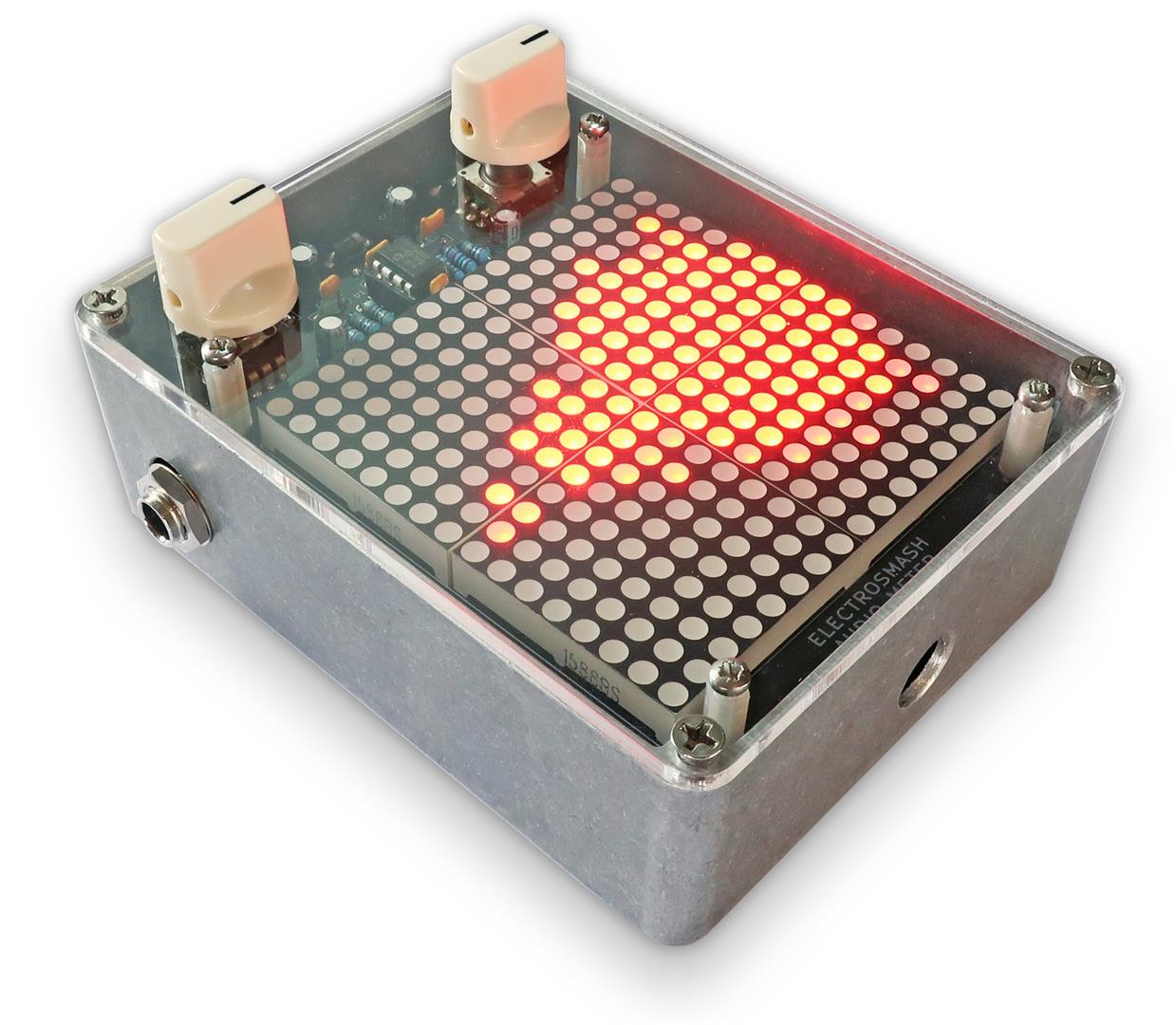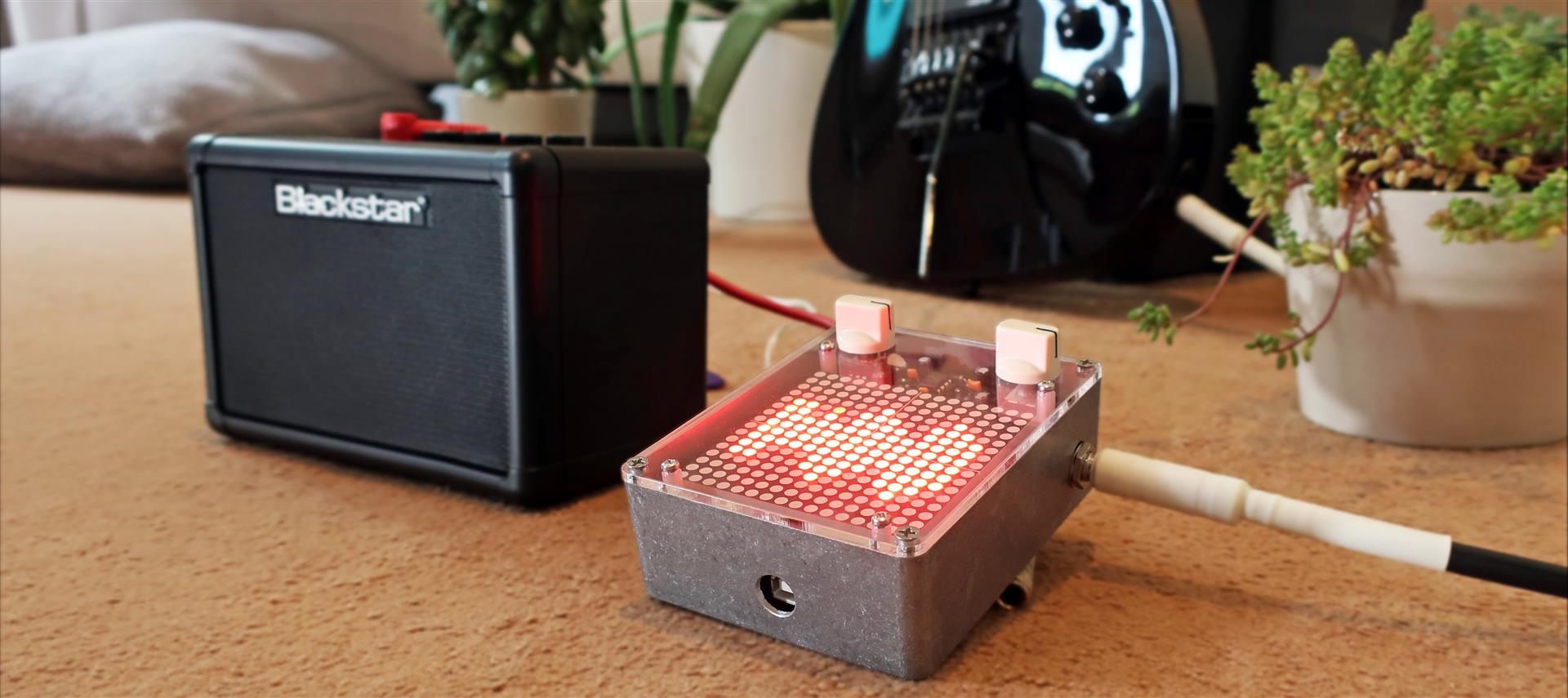The Arduino Audio Meter is a programmable guitar pedal that works with the Arduino UNO board. It is able to read the incoming audio signal and create effects on the four 8x8 LED matrices. The project is Open Source and aimed for hackers, musicians and programmers that want to learn about DSP (digital signal processing), LEDs, guitar effects, and experiment without deep knowledge on electronics or programming.
The project is designed to be fitted in a metal enclosure (Hammond 1590BBS) for better protection. There is a big library of codes available written in standard C that can inspire you. You can also post your creations in the Arduino Audio Meter online forum.
Arduino Audio Meter Specifications:
- Based on Arduino UNO board for signal processing (16MHz, 1KB RAM).
- Analog input/output stages using MCP6002 rail to rail op-amp.
- The original audio signal passes though the pedal without suffering any modification.
- Interface:
- 1 Gain knob (amplifies the guitar signal that goes into the Arduino for better resolution)
- 1 Encoder knob + Push-Button (programmable by the user)
- 4 LED matrix 8x8 (driven by four MAX7219)
- Connectors:
- Input Guitar Jack, 1/4 inch unbalanced mono, Zin=1MΩ.
- Output Guitar Jack, 1/4 inch unbalanced mono, Zout=0.1Ω.
- Power supply:
Arduino Audio Meter Review by BlitzCityDIY:
Have a look to the Blitz City DIY thorough review on the Arduino Meter pedal:
How the Circuit Works:
The circuit is designed not to touch or modify the original audio input. The Arduino ADC will read the guitar signal to create the LED display animation without adding any noise or change. The circuit has 3 blocks: The Input Stage and the LED Matrices and the Power Supply:
- Analog Input Stage: The weak audio input signal is amplified and filtered, preparing it for the Arduino UNO ADC (Analog to Digital Converter). A rail-to-rail operational amplifier is used (MCP6002) to amplify the signal (2 to 30 times depending on the Gain potentiomenter) so any audio input signal could be used.
- 8x8 LEDs Matrices and Drivers: Four "common anode" matrices are used creating a 16x16 display. Four MAX7219 chips are used to drive the matrices. The communication between Arduino UNO and the LEDs is made using 3 lines DIN (Data IN), CLK (clock) and Load. The standard Led Arduino Library (LedControl.h) is used in most of the examples.
- Power Supply: Using four 8X8 LED matrices makes a total of 4x8x8=256 LEDs, because of that the current could rise up to 500mA (Vin=9 to 12V). This is why we use a VXO7805-1000 (capable of 1A max. output current). A more standard 7805 could also be used but it gets hot.
 If you want to understand all the details of the circuit, check the Circuit Analysis in the forum.
If you want to understand all the details of the circuit, check the Circuit Analysis in the forum.
How to Program it:
To program the project as easy as possible we use the standard Arduino IDE. All the effects are programmed on C. All tools and programs are free-of-charge/Open Source. To control the 8x8 LED matrices, we use the LedControl library.
Basic knowledge of C is needed to understand the codes. Have a look to the "How to Start Programming the Arduino Audio Meter" for all the info.
Documentation Available:
- Arduino Audio Mater Assembly Guide.
- How To Start Programming the Arduino Audio Meter.
- PCB Plan PDF.
- Schematic PDF.
- Bill of Materials (BOM) PDF.
- 1590BBS Arduino Audio Meter Drilling Stencil PDF.
- Forum.
Buy Arduino Audio Meter online.
There are 2 options in the online shop:
- Order only the PCB. It uses easy-to-find standard components and you can build the kit yourself. The bill of materials is public with all the references and the Mouser part numbers.
- Order the Full Kit: This kit includes the PCB, Cover and all the components to build the Arduino Audio Meter at home.
If you have any question, contact us.
Arduino Audio Meterzer Bill Materials / Part List:
The components are easy-to-find through-hole parts with the minimum number of references:
| Arduino Audio Meter - Bill of Materials | ||||
| Reference | Description | Manufacturer/Mouser PN | Manufacturer | |
| Units | Resistors | |||
| 6 | R5,R6,R8,R9,R10,R11 | 10KΩ Res 1%, 1/4W | MFR-25FRF52-10K | Yaego |
| 2 | R2,R4 | 470Ω Res 1%, 1/4W | MFR-25FRF52-470R | Yaego |
| 1 | R3 | 100KΩ Res 1%, 1/4W | MFR-25FRF52-100K | Yaego |
| 1 | R1 | 1MΩ Res 1%, 1/4W | MFR-25FRF52-1M | Yaego |
| 1 | RV1 | 100K potentiometer | RK09K1130C94 (or RK09D1130F30B104 or PTV09A4025UB104) | Alps |
| Capacitors | ||||
| 6 | C1,C7,C9,C11,C13,C15 | 100nF | SR211C104KARTR1 | AVX |
| 2 | C3,C4 | 270pF | 594-K332K15X7RF5TL2 | Vishay |
| 8 | C2,C5,C6,C8,C10,C12,C14,C16 | 10uF | 667-ECE-A1HKA100B | Panasonic |
| Diodes | ||||
| 1 | D1 | 1N5817 (or 1N4148, 1N4001) | 511-1N5817 | STMicroE |
| 4 | D2, D3, D4, D5 | 8x8 LED Matrix (38x38mm) common anode. | 1588BS (eBay, Amazon, Aliexpress) | Various |
| Semiconductors | ||||
| 1+1 | U1 + socket | MCP6002 (or TL972) | 579-MCP6002-I/P | Microchip |
| 4 | U2,U3,U4,U5 | MAX7219 | 700-MAX7219CNG | Maxim |
| 1 | U6 | VXO7805-1000 | 490-VXO7805-1000 | CUI |
| Other | ||||
| 1 | ENC1 (Encoder) | Encoder with Switch Button | EC11E15244G1 (or RE111F-41B3-25F-15P a bit longer) | Alpha |
| 1 | J1 | 2.1mm DC Power Jack | 163-4302-E | Various |
| 2 | J2, J3 | 1/4 Stereo Jack | 568-NYS2343 | Rean |
| 1 | Enclosure | Hammond 1590BBS | Any color from 1590BBS series | Hammond |
| 1 | Board to board connecors | Pin header 40 pins 2.54 | 710-61304011121 | Various |
| 1 | Interconnection wire (40cm) | 22 AWG solid core wire | - | Various |
| 2 | Knobs | Davies 1510 model | 1510AH | Davies |
| 1 | PCB + Acrylic cover | Printed Circuit Board | Arduino Audio Meter | ElectroSmash |
| 4+8 | 4x M2.5x12mm Nylon Spacers 8x M2.5x8mm screws | Spacers and screws | Hardware store | Various |
Thanks for reading, all feedback is appreciated: This email address is being protected from spambots. You need JavaScript enabled to view it.
Frequently Asked Questions (FAQ):
What is Arduino UNO?
- Arduino UNO is a single-board microcontroller to make using electronics in multidisciplinary projects more accessible. The hardware and software are open-source.
Where can I buy Arduino UNO board?
- All major suppliers like Mouser, element-14, Digikey, RS-Online have it in their catalog and also you can find it on eBay, Amazon and physical electronic shops like Maplin or Radioshark.
Is the Arduino Audio Meter compatible with other Arduino boards?
- No, only with Arduino UNO. We also have other shields that work with other Arduino boards: pedalSHIELD MEGA, pedalSHIELD DUE, Pedal-Pi.
It is suitable for other instruments?
- Yes, you can use an electric guitar, bass, keyboard, mp3, laptop, line level, etc...
Can I plug headphones directly into the Arduino Audio Meter?
- No, the Arduino Audio Meter is not an amplifier. It needs to be plugged into a guitar amplifier or any line level input device (laptop, amp, etc)
Some Rights Reserved, you are free to copy, share, remix and use all material.
Trademarks, brand names and logos are the property of their respective owners.









